In-Depth with the Windows 8 Consumer Preview
by Andrew Cunningham, Ryan Smith, Kristian Vättö & Jarred Walton on March 9, 2012 10:30 AM EST- Posted in
- Microsoft
- Operating Systems
- Windows
- Windows 8
There are two versions of Internet Explorer 10 in Windows 8—a Metro app and a desktop app. Both share the same rendering engine and, unsurprisingly, perform identically on the same hardware. The only difference is UI, and the fact that Metro’s IE will not run plug-ins like Adobe Flash or Microsoft’s own Silverlight.
To reflect the distinction between the Metro version of IE and the desktop version, both Metro and the desktop retain separate default browser settings—you can run Firefox or Chrome as your default browser on the desktop and stick with IE in Metro, but you can also specify desktop browsers as the default Metro browser, meaning that links clicked in Metro apps like Mail will dump you to the desktop to open rather than stay in the Metro interface. Oddly, if you decide not to use IE as your default Metro browser, the IE completely disappears from Metro, and it takes a trip into the desktop Internet Settings control panel to re-enable it.
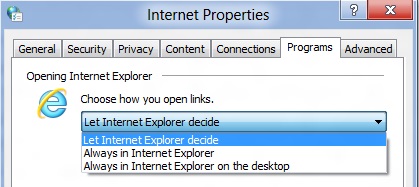
The Metro version of IE is a minimalist, touch-centric affair—the address bar is located at the bottom of the screen, and will disappear from view when it’s not being used. While typing in the address bar, IE will display a tiled list of your most frequently visited sites, as well as sites that you have “pinned” using the address bar’s pin button—these pinned sites will also show up on the Start screen. The address bar also has the requisite Back, Forward, and Refresh buttons, as well as a Tools button that will let you search the current page or open the page in the desktop version of IE (the desktop version contains no such button to open pages in Metro mode, at least for now).
The most consistent way to bring up the address bar on a PC is by using the Windows + Z keyboard shortcut that we discussed earlier, which will also bring up Metro IE’s tab interface, which displays big, clickable thumbnails of all your open tabs. You can also open new tabs, clean up your tabs (which closes all but the active tab), or open a new InPrivate browsing tab, which is clearly marked with a blue “InPrivate” icon.
The desktop version of IE looks more or less like IE9, though of course the UI hasn’t necessarily been finalized at this point. One of the only noticeable differences is the presence of a Metro-style scrollbar on pages that require one. Also new is an “Install new versions automatically” checkbox in the About Internet Explorer page, reinforcing Microsoft’s desire to get and keep Windows users on the most current IE version their operating system supports. There’s no evidence that Microsoft plans to move to the rapid-release cycle that Google and Mozilla have both adopted (such a decision would give enterprise IT managers apoplexy), but this sort of functionality would theoretically make it possible.
Benchmarks
Now, let’s peek under the hood and get a few performance numbers. According to these basic tests, IE10 is faster than IE9 by a noticeable margin, but it can’t quite catch up to the current versions of Firefox or Chrome. These benchmarks were all run on the Dell Latitude E6410 that served as my main Windows 8 machine for this review.
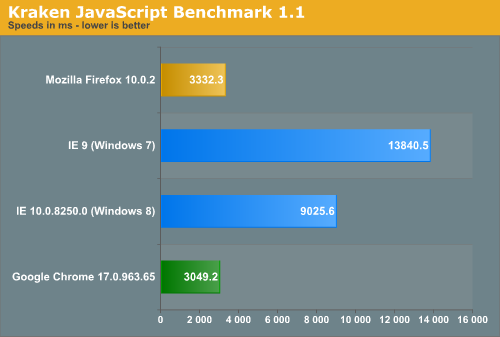
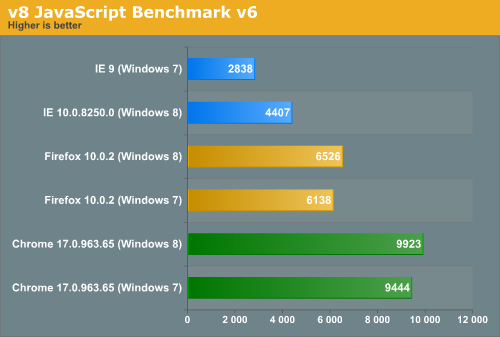
Interestingly, all browsers performed the v8 benchmark slightly faster in Windows 8. The difference isn’t huge—just a few hundred points in both cases—but it is both consistent and measureable, and I thought it interesting that the OS update slightly improved the performance of these third-party programs. Kraken scores were consistent across Windows 7 and Windows 8.


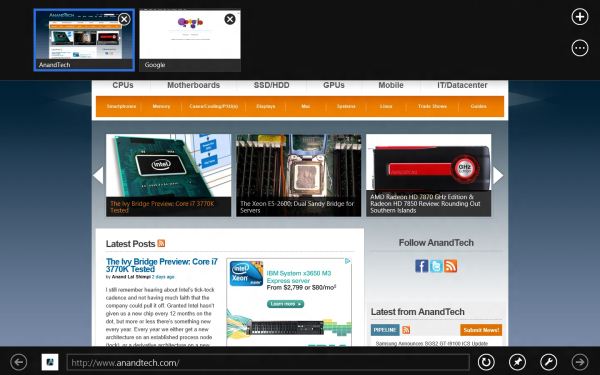
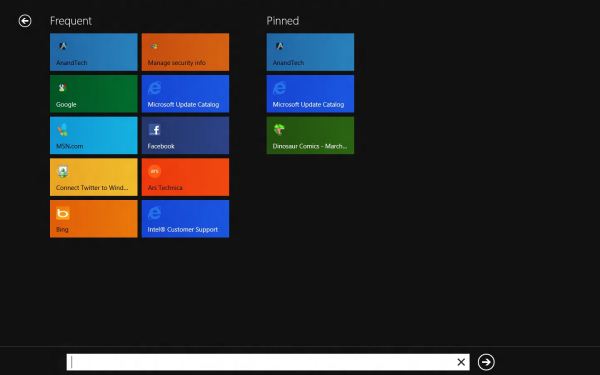
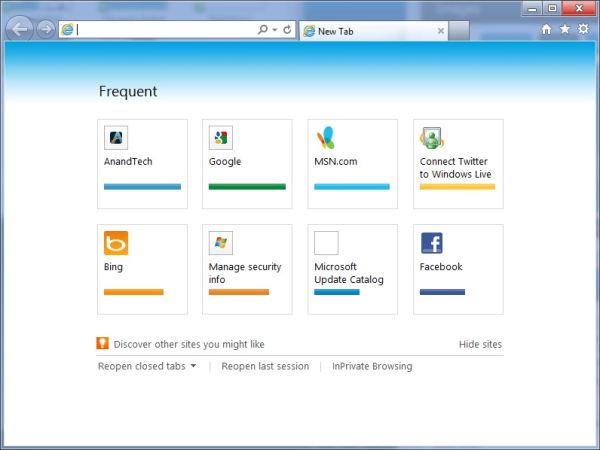








286 Comments
View All Comments
phexac - Friday, March 9, 2012 - link
I most definitely plan on skipping Win8, even though I upgraded to Vista and Win7 the day they came out.To know how bad this new disjointed Metro-Desktop environment will be, all you have to do is look at the POSITIVE feedback Win8 is receiving. Apparently, the best that can be said about Metro is that you can be fine with it and it will not create significant problems for that you cannot get around. Where is the feedback of all the great new improvements Metro will bring to your Windows experience? There is none. The best possible scenario for Metro is that, with some practice and adjustment, it will not completely fuck up your computing experience. No thanks. I will opt to stay in full desktop environment that does not force me to deal with a screen filled with ugly tiles that lead to gimped mail and other apps designed for a phone. When I am on a desktop, I want to use a desktop interface and those things called "applications." Hint--they are like apps, except with more functionality to take advantage of greater flexibility of the PC.
Metro seems to be a product of semi-competent management under pressure to do SOMETHING, ANYTHING at all to justify its job in the face of competition that is putting out meaningful well-received innovation. This situation is all too common at Microsoft it seems.
I foresee Win8 being an even bigger flop than Vista. The fact that Metro interface failed miserably in the phone market (devices it's supposed to be best on) is a pretty good indicator that it fucking blows and has no traction with consumers. The logical conclusion from that is certainly not trying to pawn it off on your desktop users.
I hope this product leads to MS losing a shitton of money so that they hopefully learn to listen to feedback of their customer base. Do you guys remember the extensive consumer input and feedback that MS used to design Windows 7? That led to a great product. None of that seems to be happening with Win8, where MS is back to its internal ideas. We all know how good that tends to work for them as of late.
I can see the commercials now: "Hi, I'm a Mac, and I have a User Interface that is not fucking retarded."
PopinFRESH007 - Sunday, April 15, 2012 - link
I love this analysis. You are truly inspired. :)antef - Friday, March 9, 2012 - link
Did I read this right? If you use File History you can't also create system images using Windows Backup? So in Windows 7 they give me an awesome, easy, built-in system imaging tool, but crap file backup so I have to find my own utilities for that, then in Win 8 they give me awesome file backup but take away system imaging? Why in the world could that not be integrated with the new feature?Andrew.a.cunningham - Saturday, March 10, 2012 - link
You can still make images and backups with the "Windows 7 File Transfer" control panel, which is identical to the Windows Backup tool. You just can't schedule both W7 File Transfer backups AND File History backups.antef - Saturday, March 10, 2012 - link
Thanks for the reply (didn't expect one this many pages deep!). That is still a shame, I like my weekly scheduled system image backups so that if something goes wrong with the system it's easy to get back to how things were. And I would be very interested in keeping File History enabled too. It seems like an unnecessary limitation and keeps it from still being competitive with Time Machine. Let's say I do enable the system image backups. Can I still get to Win7-like "previous versions" of files at all, or would that all be shut off?Malih - Saturday, March 10, 2012 - link
I don't understand why some people don't like or even hate the Metro interface. It's a beautiful, and depends on how you're using it, can be your source of quick info (with the widgets and all that) without having to open many apps at the same time.I do think it would work better on desktop or laptop if there's a device like the Magic Trackpad for PC.
I like Metro, and even contemplated on buying the Nokia Lumia 800, if only its price (the Int'l version) is a bit lower.
SunLord - Saturday, March 10, 2012 - link
It's not that hard to understand metro sucks with a mouse on my desktop and is rather disjointed but It's actually not that bad with a touch pad on my laptop where you can do swipes and other gestures so it's probably pretty sweet with a tablet/slate or a all-in-one with a touchscreen that takes advantage of the touch based interface that metro is.B3an - Saturday, March 10, 2012 - link
Complete BS.Metro is faster and more configurable than the Start menu ever was, as this article also points out. Getting stuff done on Win 8 is faster than it ever was in 7. People need to stop trying to use Win 8 like 7 and use it for how it's intended. It's an improvement. Not that people like you will ever give it a chance. Too scared of change. Go back to DOS.
TEAMSWITCHER - Saturday, March 10, 2012 - link
You're wrong. The first time I did a search for "Settings" in Metro I was presented with a ugly grid of small icons and text. Many of the icons were duplicates and some I swear haven't changed since Windows XP. I thought to myself - "Wow, Metro just vomited on my 27" display."If you honestly think that Metro is going to compete visually against the iPad you must be partially blind. Just take a look at the blocky green slider buttons in Metro and compare them to the awesome round and shaded slider buttons of iOS. Metro looks like crap!
Stop saying good things about it - it's the worst OS Microsoft ever created!
stephenbrooks - Saturday, March 10, 2012 - link
1. It would be nice if there was a special "maximise" button that turned a window from your desktop into a Metro "app" that showed up on the list of running apps. What I like about Metro is that Microsoft are embracing the fact that some things are better fullscreen, so there's a selection between screens and then overlapped windows on a desktop within one of those.2. It would also be nice if they had skinned the desktop to look Metro-ish, instead of the utterly different look and feel of the two at the moment. Just needs everything to have square non-bevelled borders + black background really and use solid shading rather than gradients or fancy stuff.
The big reason why I think #1 isn't happening, and the problem with Metro generally, is that it only works with apps written against Microsoft's very specific Metro system. I don't know if they intend to keep this dichotomy forever. They can't migrate entirely to Metro because then developers would have to put all their half-made and experimental programs through the microsoft app approval system! Plus there are things that don't lend themselves to going in the Windows Store, like programs written internally in a company, various sorts of scripts, bespoke simulations used in R&D, etc.
In fact all the *clever* stuff people do with PCs doesn't work in the consumerised app store/tablet model as it stands.